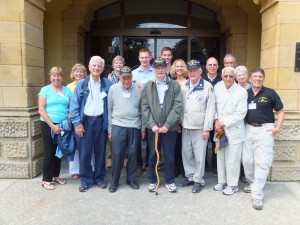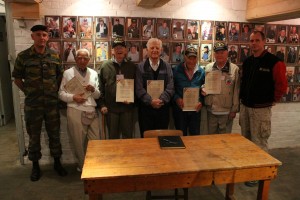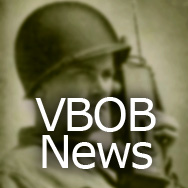VBOB – SOUTHERN BULGE TOUR – June 15th to the 25th, 2014

The VBOB Luxembourg American Friendship Week (LAFW) and Southern Bulge Tour in June, 2014 proved to be a trip of a lifetime. I completed a personal vow that I’d walk in some of the towns and villages where my father (131st Armored Ordnance Battalion – 9th Armored Division) fought in the Battle of the Bulge. Although, he would never discuss his experiences in the Battle of the Bulge, my father would jokingly grouse that the Nazis screwed up his chance of getting a birthday weekend pass on that historic day of December 16, 1944 – the day the battle began. As a 1st generation American, my father loved this country deeply, and upon his military discharge in 1946, he spent the next 36 years as a Master Sargent and proud member of the Army Reserve’s 331st General Hospital unit based at Fort Devins, MA
On Sunday, June 15th, under the superb guidance of Patrick Hinchy (our tour guide & historian), a group of us (Harry Whisler, a highly decorated medic with the 10th A.D., his family, and I), made our way out to the Normandy region. On the way, we stopped at the massive Chateaux de La Roche-Guyon, used as the HQ of Field Marshall Erwin Rommel while he built-up the Normandy coastal defenses. Not only did the chateaux serve as the HQ of Rommel’s Army Group B, but it was also the meeting place of several very high ranking German officers, including Rommel’s Chief of Staff, General Speidel, and other conspirators as they plotted to remove Hitler from power in July of 1944.
From our hotel “HQ” in Bayeux (Normandy), we toured the D-Day Museum (Musee Memoriale Battaille de Normadie), and saw the famous Bayeux Tapestry, a remarkable 900 year old, 230 foot long hand embroidered panels showing Normandy’s William The Conqueror, sailing to England to defeat Harrold at the historical Battle at Hastings in 1066 A.D. The following day, June 16th, we walked on the beaches – Arromanche, Port en Bessin, Omaha, Utah, and saw Pointe du Hoc. We peered out of the concrete bunkers and over the edge of the cliffs, and saw the perspective that the enemy had as they fired on the Allied troops. It’s amazing that any of the GIs made it past the beaches or up over those cliffs as they dodged the gunfire. With bomb craters evident everywhere, the entire area is a vast permanent monument to the courage and sacrifice of men who arrived on Utah and Omaha Beaches on D-Day. From there, it was short trek to the solemn Normandy American Cemetery and Memorial Museum at Colleville-sur-Mer. It was then on to see the famous Parachute Memorial at the Church of St. Mary in St. Mere Eglise – the very first village in France liberated by mixed units of the 82nd & 101st Airborne.
We returned to Paris on June 17th to meet up with the rest of the tour group, boarded a high speed train to Luxembourg, and then on to our hotel in the wonderful little village of Gonderange, just northeast of Luxembourg City. That evening we all enjoyed a hearty dinner with a most friendly group from the US Veterans Friends of Luxembourg (USVFL). The following day, June 18th, we took in the sights, sounds, and smells as we walked through the vibrant & historic center of Luxembourg City. At the Foundation Pescatore, General Patton’s HQ in Luxembourg, the entire group watched as each of the veterans (87th Divisions’ John McAuliffe – 347th IR, Charles Pefinis – 345th IR, Ken Yockey – 336 FAB, as well as Harry Whisler – 61st Armored Infantry of the 10th AD, and Ike Refice – 80th Div. 319th IR) were honored at a special ceremony, with each veteran presented medals and citations.
Next on the agenda was quick visit to the VBOB Monument across from the Pescatore, followed by a very solemn 70th anniversary wreath-laying rededication at the US Cemetery at Hamm attended by Carolyn Turpin, Public Affairs Officer from the US Embassy. Flowers were placed at the grave of Gen. Patton, and Ike Refice located the grave of Sgt. Day Turner, also of the 319th IR, who was awarded the Congressional Medal of Honor for his heroics at the Astert Farm battle in Dahl, Luxembourg. Just a short trip down the road was the German cemetery with its mass grave of unknowns and plain grey granite headstones – a very stark contrast to the gleaming white marble headstones of the US cemetery. That evening, we attended the Celebration of the Four Chaplains and a festive dinner in Oetrange, Luxembourg. Several toasts were offered, including a rather poignant account by a former German soldier who was captured during the Bulge and was a POW at Ft. Devins, MA until 1946. He recounted that it was there that he came to know the true meaning of freedom & respect for America – a profound experience that changed the rest of his life.
On June 19th, we went to a local high school in Diekirch and had a Q&A session with the students. They were spell-bound as the veterans, in response to the students’ many thoughtful questions, recounted some of their experiences in the Battle of the Bulge Following the discussion, our tour group and several representatives from USVFL enjoyed a wonderful lunch ceremony in the ‘student restaurant.’ Jeffry Olesen, the U.S. Embassy Deputy Chief of Mission, was in attendance and gave a wonderful testimonial to the accomplishments of the vets. After lunch, we visited the National Museum of Military History in Diekirch. Our bus then crossed over the Sauer River into Germany to Wallendorf and Ammeldingen. We made a quick stop in Medernach at the 9th Armored Memorial, that honors its three combat commands (CCA, CCB, and CCR) in Bastogne, St. Vith, Clervaux, Ermsdorf, Waldbillig, Troisvierges, Longvilly, Medernach, Larochette, and Werbomont. That evening, we joined many of the USVFL members for another hearty dinner and sampling the wonderful local wines.
On June 20th, after visiting the George Patton Memorial, the Wiltz Defense memorials to the numerous units of the 3rd Army at Schummans Eck and then experiencing goose bumps while stepping into the remnants of various foxholes in the surrounding woods, we spent the majority of the day in and around the town of Bastogne. We saw the Memorial du Mardasson – a truly impressive memorial. Climbing to the top of the Memorial offers a 360 degree panoramic view of the countryside where the battle for Bastogne was fought. We visited the Bastogne War Museum on the same grounds as the Memorial and saw numerous multimedia exhibits that helped explain that epic battle for Bastogne.

After a quick stop at the 10th Armored Memorial, the tour group arrived at the Bastogne Barracks. It was here on Dec. 22, 1944, when General von Lüttwitz, commander of the German forces surrounding Bastogne, demanding the surrender of US forces, that General Anthony McAuliffe famously responded “Nuts.” When the barracks’ commanding officers (Colonel Olivier D’Hoop and Commandant Eric Lemoine) realized there were 5 WWII veterans of the Battle of the Bulge standing at their gate, they pulled out the stops and guided our group to a private tour of the facility. The veterans were treated royally, as they were asked to sign a special veterans guest book and had their photos taken for the ‘Wall of Honor’ in McAuliffe’s bunker. On the way back to the hotel, we visited memorials to the 87th ID in the towns of Tillet and St. Hubert, and discussed the action there with 87th ID veterans Charles Pefinis & John McAulliffe (no relation to the General!).
On Saturday, June 21, Daniel Reiland, Pres. of the USVFL group and I went off to tour Schoenfels, Lintgen, Mersch, Nospelt, Savelborn, Troisvierges, and Clervaux – many of the local towns & villages where the 9th Armored Division units fought in the Southern Bulge sector. The rest of the tour group went on to the Saar-Moselle Triangle where the vets were honored at the re-dedication of the 94th ID monument by several dignitaries including Helen Patton, granddaughter of George Patton.
On Sunday June 22, the group attended a very solemn re-dedication of the 10th AD memorial in Berdorf, where the mayor led a gathering of towns people in the ceremony along with a special presentation honoring Harry Whisler, as his battle exploits were recounted by his son-in-law, Jim Jones. We then traveled up to the West Wall Museum, a Siegfried Line bunker complex in Irrel known as the “Cat’s Head”, set into the hillside in the South Eifel region. It was the 2nd largest fort of its kind on the West Wall, and was an amazing complex containing MG34 gun turrets, a 500mm grenade launcher, a flame thrower, and 45 rooms underground that housed up to 80 soldiers. It was then on to Echternach and a stop at the 3rd Army memorial and a visit to the impressive St. Willibrord Basilica in Echternach with its stunning frescoes and white marble sarcophagus, containing the remains of St. Willibrord. Built in 698, it was nearly completely destroyed during the Battle of the Bulge, but rebuilt after the war and celebrated its 1300th anniversary in 1998. That evening’s dinner was served up at a wonderful winery in Ahn, Luxxembourg, a picturesque village along the Moselle River – just outstanding food & wines.
On Monday June 23, after celebrating Luxembourg’s National Day with church services at St. Vincents in Dahl, it was on to the Sgt. Day Turner memorial at the Astert Farm. Here, Ike Refice recited the story of the battle that his friend Sgt. Turner and his squad fought at the farm on January 8, 1945. For 4 hours the savage fighting continued, some of it hand-to-hand. There were 11 dead and many other wounded Germans, and with only three in his squad unwounded, Sgt. Turner brought an end to the battle and rounded up 25 German prisoners. For this heroic action, Sgt. Turner received the Congressional Medal of Honor, posthumously however, as Sgt. Turner was killed in action attacking a West Wall bunker in Wallendorf on February 8th, one month to the day of the battle at the Astert Farm.
Following a wonderful lunch at Aflamm’s with Lucy Leners of the Astert Farm, the group proceeded to a rededication of a memorial to Alfred Etchevery, a GI killed in action in Goesdorf. That evening, at the bon voyage dinner at the hotel in Gonderange with many of the USVFL representatives, there were many toasts with the highlight being the grand toast by Helen Patton, and then leading everyone in songs & tributes to the veterans.
On Tuesday, June 24, the tour group left Gonderange and enjoyed a leisurely motor coach ride through the picturesque Mosel River Valley, with a stop to tour the famous ‘picture post card’ wine town of Bernkastel. In Koblenz, we visited the famous statue of Kaiser Wilhelm located on the point where the Mosel & Rhine rivers intersect. This was the same statue that Ken Yockey’s 87th FAB were ordered to shell & destroy as the GIs approached Koblenz in ‘45. It was also here that a couple of GIs in Charles Pefinis’ unit found a champagne cellar, drank too much, threw a hand grenade and inadvertently captured a few dozen or so Nazi soldiers for which they received medals. Here the group boarded for cruise down the Rhine to Boppard where the group was met by the current & former mayors of the town. We enjoyed a wonderful lunch & sampled the several wines as guests of the Sylvia the “Wine Queen” at Bopparder Weinkonigin. It was then on to City Hall, where the Mayors honored the vets, followed by a rededication ceremony of a stone memorial to the 87th Division, where on the night of March 24th, 1945, they finally crossed the Rhine River.
The tour group spent that night in Frankfurt, and the next day caught flights home full of priceless memories. This recounting is dedicated to those veterans who made this 70th Southern Bulge Anniversary trip so special, to my father and all the other men & women of the Greatest Generation who experienced firsthand the Battle of the Bulge, and especially to Ken Yockey, who unfortunately passed away on July 4th – 10 days after returning to his home in Ohio from the trip.
By Michael LoPiano – Associate Member
